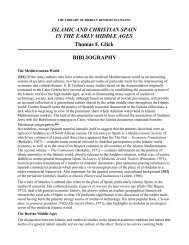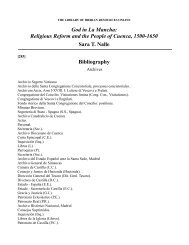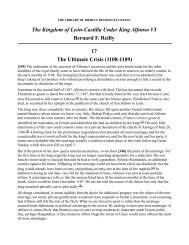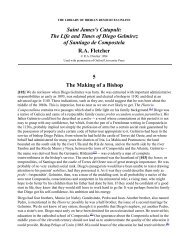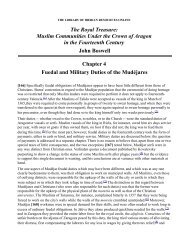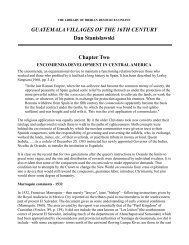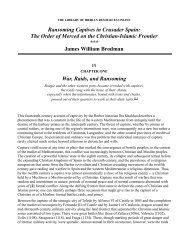The Cluniac Priories of Galicia and Portugal - The Library of Iberian ...
The Cluniac Priories of Galicia and Portugal - The Library of Iberian ...
The Cluniac Priories of Galicia and Portugal - The Library of Iberian ...
You also want an ePaper? Increase the reach of your titles
YUMPU automatically turns print PDFs into web optimized ePapers that Google loves.
<strong>Portugal</strong> <strong>and</strong> <strong>Galicia</strong>.<br />
For the present inquiry the most pertinent fact is that after some twenty years the Province <strong>of</strong> Hispania<br />
was subdivided <strong>and</strong> a second Ibero-<strong>Cluniac</strong> circumscription, that <strong>of</strong> <strong>Galicia</strong>, came into being. <strong>The</strong><br />
existence <strong>of</strong> this new cameraria, which had disappeared well before 1250 <strong>and</strong> therefore receives no<br />
mention in our late medieval descriptions <strong>of</strong> the Burgundian federation, can be proved from four<br />
different witnesses:<br />
(a) an undated letter <strong>of</strong> Abbot Radulfus (Raoul de Sully, 1173-1176), directed to all the <strong>Cluniac</strong><br />
priors <strong>of</strong> Hispania. This text, one <strong>of</strong> three found in a small register or cuaderno <strong>of</strong> the late 12th or<br />
early 13th century preserved among the pergaminos <strong>of</strong> San Zoil de Carrión, confirms the authority<br />
<strong>of</strong> a Prior Humbert <strong>of</strong> San Zoil as camerarius Hispaniae in these words: "Volumus autem uobis<br />
omnibus esse manifestum quod omnium rerum que per Hispaniam preter <strong>Galicia</strong>m possidemus,<br />
ipsum toto tempore uite sue camerarium et ordinatorem ex integro constituimus". (120)<br />
[340] (b) a diploma <strong>of</strong> Santa María la Real de Nájera, issued in 1183 by its prior Guido, who styles<br />
himself "ego Guido prior de Naiera et camerarius Gallecie". (121)<br />
(c) a letter <strong>of</strong> Pope Innocent III dated 28 Juanuary 1205, requesting archbishop <strong>of</strong> Toledo <strong>and</strong> his<br />
suffragans to assist Abbot Hugh V <strong>of</strong> Cluny in his projected visitation "ad partes Hispaniae et<br />
<strong>Galicia</strong>e pro reformatione ordinis circa domos quas in partibus illis habere dignoscitur". (122) This<br />
geographical terminology, which must echo that supplied the papal chancery in the abbot's earlier<br />
request, shows Cluny still possessing two peninsular camerariae.<br />
(d) the appearance by at least 11 July 1225 <strong>of</strong> a new formula for the Hispanic chamberlain:<br />
"camerarius totius Hispanie" or, in Romance, "carnerero de toda España de la Orden de Crunego".<br />
(123)<br />
This subsumes the abolition <strong>of</strong> the Gallegan province <strong>and</strong> the restoration <strong>of</strong> its constituent<br />
houses to the original Hispania.<br />
<strong>The</strong>se four texts confirm the existence <strong>of</strong> a cameraria Gallecie in the later 12th <strong>and</strong> first quarter <strong>of</strong> the<br />
13th centuries. But when, <strong>and</strong> why, was this second <strong>Iberian</strong> province created? How is the strange link<br />
with Santa María to be explained? Did <strong>Cluniac</strong> '<strong>Galicia</strong>' include the three priories in <strong>Portugal</strong> as well as<br />
the four <strong>of</strong> <strong>Galicia</strong> proper? None <strong>of</strong> these question can now, or perhaps ever, be answered with finality<br />
but some progress towards their solution can be made, particularly since the role <strong>of</strong> Nájera as<br />
camerarial capital allows us to draw not only upon the limited Gallegan <strong>and</strong> <strong>Cluniac</strong> evidence but also<br />
upon Santa María's fuller documentation.<br />
[341] 1. <strong>The</strong> establishment <strong>of</strong> the Cameraria Gallecie. <strong>The</strong> subtraction from the Hispanic<br />
chamberlaincy <strong>of</strong> certain priories placed under a camerarius Gallecie must already have occurred<br />
before the dispatch <strong>of</strong> Radulfus' epistle to the priors <strong>of</strong> Hispania, for the phrase preter <strong>Galicia</strong>m here is<br />
too casual, too devoid <strong>of</strong> juridical formality to have effected the actual institution <strong>of</strong> the new<br />
administrative district. Furthermore, the two other letters <strong>of</strong> Radulfus also contained in the Cuaderno<br />
Carrionense <strong>and</strong> <strong>of</strong> the same date, <strong>of</strong> which one is addressed to the prior-chamberlain himself while the<br />
other is directed to Gerald, custos ordinis, <strong>and</strong> the chapter <strong>of</strong> San Zoil, are silent regarding <strong>Galicia</strong>. <strong>The</strong><br />
assumption must be that the recipients already knew the territorial limits <strong>of</strong> Humbert's authority. All<br />
three texts cannot date later than 1176; actually their content <strong>and</strong> purpose place them early in Radulfus'<br />
abbatiate, which began in late 1173, so that they are most likely to have been written soon after his<br />
election, probably in 1174. (124)<br />
But how long before late 1173 or 1174 can the division into two provinces be placed, <strong>and</strong> under what<br />
abbot? Humbert must have been appointed to his double <strong>of</strong>fice <strong>of</strong> prior <strong>of</strong> Carrión <strong>and</strong> Hispanic<br />
chamberlain by Radulfus' predecessor Stephen (1161-1173) some time between 13 January 1167, when



